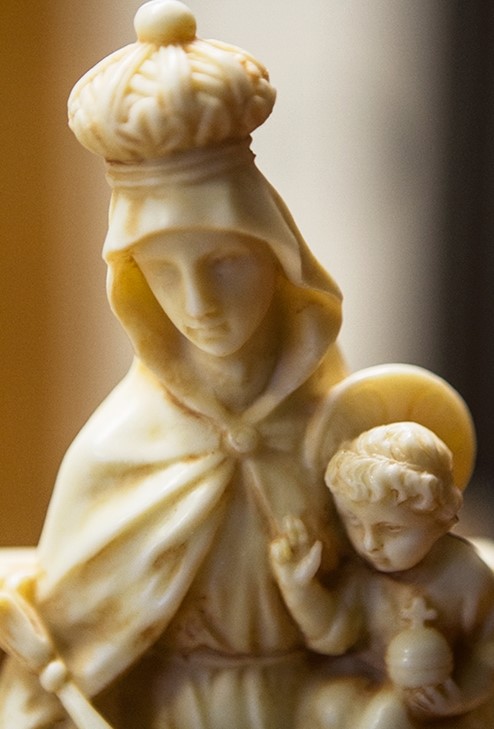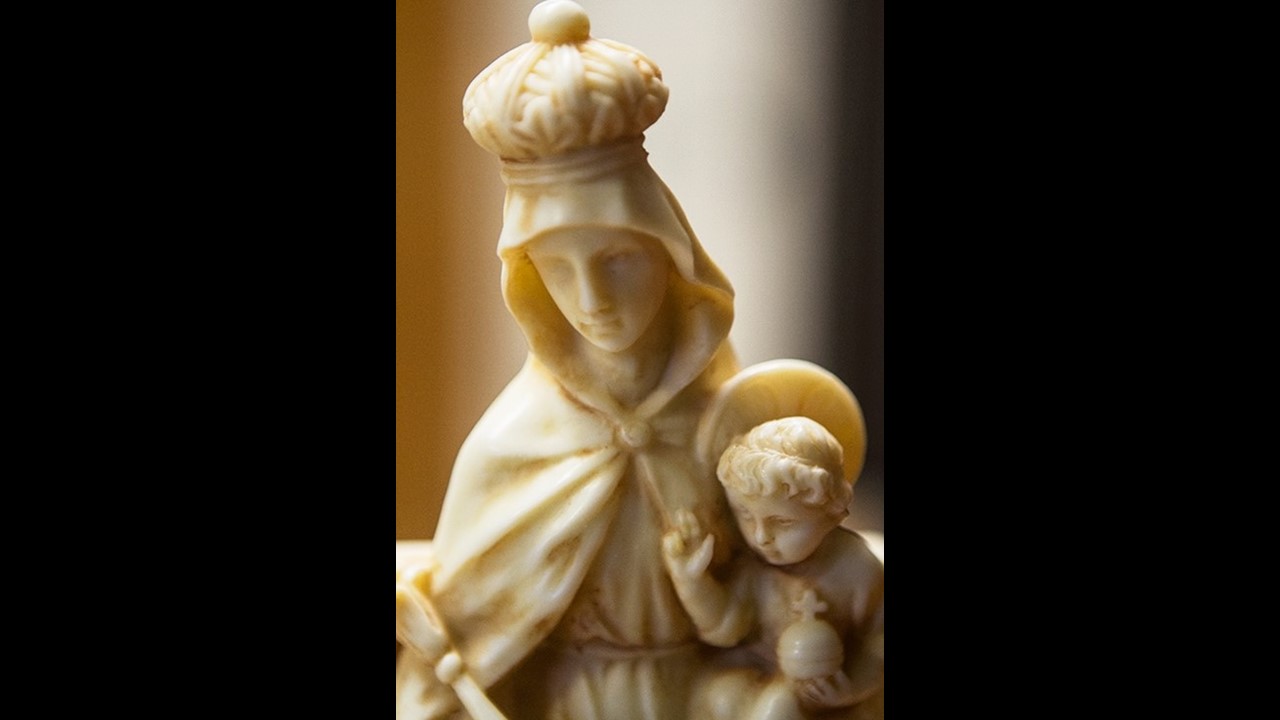Queen of All Hearts
Fr. Thomas B. Graham, SMM
Explaining the title Mary, Queen of All Hearts
Rev. Thomas Graham, S.M.M., member of the Montfort Fathers, makes his first appearance in The Queen.
Queen of All Hearts
M ARY’S queenship in recent theology as well as in the doctrine of Montfort is based on
two theological truths: the divine maternity and the co-redemption.
Evidently, the divine maternity is the foundation of all the other prerogatives of Mary. Montfort does not delay in explaining the nature of the divine maternity. Mary supplied a human nature to the Son of God. This made possible the union of humanity and divinity in the person of Christ. He simply states the fact in order to draw an immediate conclusion.
Christ in His human nature is a King and Head of the Mystical Body. In mothering the whole Christ, Mary is adorned with the title of Queen. She has as well as with a domination and power over the members of the Mystical Body. She has this power, not by any natural right, but by the grace of her maternity. That is why Montfort ascribes her queenly domination to a ”singular grace of the Most High, who, having given her power over her only and natural Son, has given it also to her over His adopted children, not only as to their bodies, which would be but a small matter, but also as to their souls”.
Divine Maternity
Thus, in virtue of her divine maternity, Mary acquires a certain maternal power over Christ. This, in turn implies a queenly and dominative power over all the members of Christ. The line of argument that Montfort follows is that of St. John Damascene and other Fathers of the Church. In becoming the Mother of God Mary became the Queen and Sovereign of all that is under God. ” All that is fitting to God by nature is fitting to Mary by grace, say the saints; so that, according to them, Mary and Jesus, have but the same will and the same power. They have also the same subjects, servants and slaves.”
In his exposition of Mary’s Queenship, Montfort seems to ignore her presence and her consent on Calvary as an additional title to her royal prerogative.
Undoubtedly, he was well aware of the fact that the death of Christ on Calvary was decreed as the climax of our Redemption. He was likewise aware of the co-redemptive activity of Mary at the foot of the Cross. This co-redemptive activity of Mary, in his view, was so far reaching. He contemplates Christ as depending on ”even in His death, where she was to be present in order that He might make with her but one same sacrifice, and be immolated to the Eternal Father by her consent.”
Mary’s Presence At The Cross
But in laying the foundations for her queenship he does not insist explicitly on this phase of Mary’s co-redemptive activity. The reason for this lies in the fact that Montfort was a disciple of Bérulle. For whom the mystery of the Incarnation ”is an abridgement of all mysteries and contains the will and grace of all”. Therefore, for him, Christ is a Redeemer from the very first moment of His earthly existence and therefore all the actions of His life subsequent to His Incarnation are redemptive in character.

Mary, Queen of All Hearts
Montfort Publications’ Statue
Mary is above all and before all the Queen of Hearts. ”Now, as the kingdom of Jesus Christ consists principally in the heart or interior of man – according to the words: ”The kingdom of God is within you” – in like manner the kingdom of Our Blessed Lady is principally in the interior of man; that is to say, his soul. And it is principally in souls that she is more glorified with her Son than in all visible creatures. And so we can call her, as the saints do, the Queen of all Hearts.”
Return to more The Queen: Articles
This is quite clear when we recall that all actions of Christ are unified by the one purpose of His life, the Redemption of mankind. This is expressed theologically by the distinction “in ordine intentionis” and ”in ordine executionis” : in the order of intention they are one, in the order of execution they are distinct. Thus, Montfort conceives the Redemption as a whole, begun at the Incarnation and completed on Calvary. And the conduct of Christ towards His holy Mother in the Incarnation will be the very same at the foot of the Cross.
Both are inseparably united in the redemptive activity. “He (Christ) glorified His independence and His majesty in depending on that sweet Virgin. She is glorified in His conception, in His birth, and in His presentation in the temple. She is glorified in His hidden life of thirty years, and even in His death, where she was to be present in order that He might make with her but one same sacrifice, and be immolated to the Eternal Father by her consent; just as Isaac of old was offered by Abraham’s consent to the will of God. It is she who nourished Him, supported Him, brought Him up and then sacrificed Him for us.”
Mary’s Co-redemptive Activity
Modern theology sees an added title to Mary’s queenship, that of conquest, in her cooperation with Christ at the foot of the Cross. But Montfort lays no particular stress on this argument since it is already eminently included in her consent to the redemptive Incarnation.
There is another reason for Mary’s queenly elevation that Montfort recalls in his writings and which we will mention briefly here. It is her deep humility. As our saint puts it: ”As a recompense for her profound humility, God has empowered her and commissioned her to fill with saints the empty thrones from which the apostate angels fell by pride. This is the will of the Most High who exalts the humble, that heaven, earth and hell bend, with good will or bad will, to the commandments of the humble Mary.”
Extent of Mary’s Domination
The queenly sway of the Blessed Virgin extends, as does that of her Son, over all creation. It is truly a universal queenship in the fullest sense of the word.
First of all, she is Queen of heaven. ”In the heavens Mary commands the angels and the blessed” because God “made (her) sovereign of heaven and earth.” “All the angels of heaven . . . prostrate themselves before her, and beg of her in her graciousness to honor them with some of her commands. Even St. Michael, as St. Augustine says, although the prince of the heavenly court, is the most zealous in honoring her and causing her to be honored, and is always anxiously awaiting the honor of going at her bidding to render service to some one of her servants.”
Queen of Heaven and Purgatory
Secondly, her empire extends over the souls of Purgatory. Montfort often speaks of Mary’s intervention in behalf of the suffering souls of Purgatory and in one of his poems mentions explicitly that she is the Sovereign of Purgatory.
Thirdly, even hell feels the effect of her queenly power. The historic enmity established between her and Satan will continue to the end of the world. Montfort loves to dwell on Mary’s power to crush the demons. ”The most terrible of all the enemies which God has set up against the devil is His holy Mother Mary. He has inspired her, even since the days of the earthly paradise, though she existed then only in His idea, with so much ingenuity in unveiling the malice of that ancient serpent, with so much power to conquer, to overthrow and to crush that proud, impious rebel, that he fears her not only more than all angels and men.
But in a sense more than God Himself . . . first, because Satan, being proud, suffers infinitely more from being beaten and punished by a little and humble handmaid of God, and her humility humbles him more than the divine power; and, secondly, because God has given Mary such great power against the devils, that they have been obliged to confess, in spite of themselves . . . (that) they fear one of her sighs for a soul more than the prayers of all the saints, and one of her threats against them more than all other torments.”
Queen of Earth
This opposition will gain increasing momentum towards the end of the world. At that time when Satan will do his utmost to lead souls to damnation. At this time especially, the Blessed Virgin will come to the aid of her faithful servants and followers. And by the deployment of her queenly power and grace, will grant them ultimate victory over the powers of hell.
Fourthly, and finally, Mary is Queen of earth where everything is subject to her power. Even material things are included in her dominion. As well as the course of events which she can arrange for the good of the elect. ”She so disposes things from afar that she may exempt her servants from all sorts of evils. And obtain for them all sorts of blessings.”
But the primary exercise of her queenship on earth is wrought in the interior realm of grace. It is in the souls and hearts of men that Mary’s sovereign power is fully displayed.
Queen of All Hearts
This is the very center of Montfort’s teaching on the queenship. Mary is above all and before all the Queen of Hearts. ”Now, as the kingdom of Jesus Christ consists principally in the heart or interior of man – according to the words: ”The kingdom of God is within you” – in like manner the kingdom of Our Blessed Lady is principally in the interior of man; that is to say, his soul. And it is principally in souls that she is more glorified with her Son than in all visible creatures. And so we can call her, as the saints do, the Queen of all Hearts.”
Montfort conceives this domination over souls as a veritable right of property, and not a simple power of intercession. Just as Christ has an absolute dominion over all creation by right of nature and conquest. So, too, Mary, who was inseparably united with Him in the entire economy of salvation, shares in this dominion by grace.
Her authority does not lessen the supreme autonomy of Christ, any more than her Mediation of grace destroys the text of St. Paul proclaiming the unity of the Mediator between God and Man: Unus mediator inter Deum et homines: Homo Christus Jesus. Mary’s queenship is in an order apart and goes beyond the laws of human analogy. Her power is subordinate to and dependent on Christ. And yet, at the same time is one with Christ, to the extent that both possess the same rights and privileges. Both have the same subjects, servants, and slaves.
From these doctrinal considerations of Mary’s queenship, Montfort immediately outlines the practical applications which constitute the greater part of his spiritual writings; and which find their culmination in his act of perfect consecration to Jesus through Mary, our Mother, our Mediatrix and Queen.
The End
Vol. #009: July – August 2021



